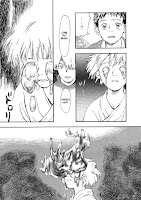


In a fantasy world where your neighbor could be a flesh eating monster in disguise, mankinds only hope of survival lies in beautiful half human, half monster girls dubbed claymores after the two handed swords they wield. On
 the flip side not everything is so great about being a claymore as they have to forever battle with the monster within, least they lose their human self and become a monster themselves.
the flip side not everything is so great about being a claymore as they have to forever battle with the monster within, least they lose their human self and become a monster themselves.The story revolves around a claymore named Claire and a human boy named Raki both who have had their entire family killed by monsters. After a series of events Raki ends up traveling with Claire. He tends to provide the readers voice throughout the narrative, for example, being shocked at the strange and terrible things Claire is forced to do. Raki's company makes Claire reveal more of her human side, his presence undoubtedly helping in her struggle to remain human.

The art is consistent, but the style seems a little dated and character designs are kind of lackluster. The layout is well set out, making the dialogue, story and action easy to follow. Claymore does feature quite a bit of violence and was probably aimed at older teens, but besides being in comic form, it's also fantasy violence, anyone thirteen or older would not be phased from it.
With the final chapter not really leading onto anything else, it's hard to tell where exactly where the story of Claymore is going. It's made apparent that Claire goes from village to village clearing out the monsters. The story is a bit weak in that regard, at least in this volume, there is no real conveyance of any greater goal to follow on through to the next volume.
![DESUAU : Pop Culture [Anime + Manga + Games] News and Reviews](https://blogger.googleusercontent.com/img/b/R29vZ2xl/AVvXsEjkF58w6aQAUnt83AcZblcUJM6r4qN0zkEij-QCtRsXtVgyU6DhQwEwT8AhihXKUm2zPClERpORX-lVsH-JU3wVPWATGS4ED1jE7DSlwehITSbw0JAq2c5Fn45oDKj2cICSEvudhjyJO1yq/s1600-r/titletop6.png)













































